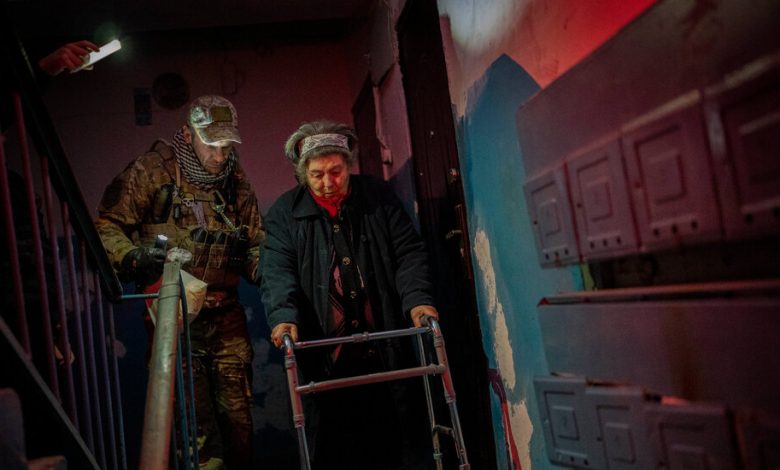Ukraine Warns of More Strikes on Power Plants, as Russians Dig In

Amid Ukrainian warnings that Moscow is preparing a new wave of strikes on energy plants, Russian forces are fortifying their defensive lines in southern Ukraine after retreating from the city of Kherson.
Since being ordered to pull out of Kherson earlier this month, Russian troops have been digging trenches and erecting barriers against the possibility of a new Ukrainian offensive east and south of the city, a gateway to the occupied Crimean Peninsula.
But the Kremlin, presumably still stinging from the bitter setbacks, on Monday dismissed widespread speculation that its forces might soon relinquish another prize in Ukraine’s south, the nuclear plant in Zaporizhzhia that it seized soon after invading in February.
“One should not look for signs where there are none and cannot be any,” said a spokesman for President Vladimir V. Putin, Dmitri S. Peskov.
The warning from Ukrainian official that Russia is preparing to unleash new attacks on energy infrastructure came even as utility crews, toiling in dropping temperatures, were working to restore power supplies devastated by recent bombardments.
Natalia Humeniuk, the spokeswoman for the Ukrainian military’s southern command, said Monday that Ukraine had received intelligence reports suggesting that the new strikes might come this week, perhaps using missiles launched from a Russian naval vessel in the Black Sea.
President Volodymyr Zelensky told Ukrainians that the week ahead could once again prove difficult. “As long as they have missiles, they won’t stop,” he said during his nightly address late Sunday.
But Mr. Zelensky said that by working together, Ukrainians would overcome “Russia’s attempt to use the cold against people.”
On Monday, a group of foreign ministers from seven Baltic and Nordic nations visited Kyiv to discuss the threat to Ukraine’s ravaged energy infrastructure ahead of winter. Representatives from Estonia, Iceland, Latvia, Lithuania, Sweden, Finland and Norway met with Mr. Zelensky in the Ukrainian capital and addressed humanitarian and military aid, sanctions on Russia, and Ukraine’s bid for membership in the European Union.
The warning about new infrastructure attacks came as the Institute for the Study of War, a research group based in Washington, said in a report on Sunday that satellite imagery showed Russian forces prioritizing digging trenches and erecting so-called dragon’s teeth anti-tank defenses on the east bank of the Dnipro River, across from Kherson city.
“The Russian defensive positions suggest that the Russian military leadership views the prospect of a Ukrainian offensive across the Dnipro River as a serious threat,” the institute said. The group offered no prediction on whether Ukrainian forces might in fact attempt such a crossing.
Western military analysts have speculated that rather than attempt a dangerous river crossing near Kherson, Ukraine’s military might instead attempt a new offensive starting far upstream, where it already controls land on the east bank of the Dnipro.
Ukraine’s rivers have proved a formidable obstacle for both sides in the conflict, with attempts to cross them often putting troops in vulnerable positions. Analysts say that any concerted attempt by Ukrainian forces to cross the Dnipro would most likely involve extensive preparation.
The Ukrainian authorities have declined to give details of military operations in the south since the recapture of Kherson. Ms. Humeniuk, the Ukrainian military spokeswoman, said Monday that an operation to take control of the Kinburn Spit, a peninsula at the mouth of the Dnipro River, was ongoing.
“This is very difficult work,” she said on national television, citing the increasingly harsh weather conditions as winter approaches, as well as the location of the peninsula.
Even before Kherson was lost, Russia had begun building a string of defensive positions in the eastern part of the Kherson region, the Institute for the Study of War report said. By Nov. 15 — four days after Ukrainian forces triumphantly swept into the city — satellite images showed trenches and concrete anti-tank defenses, pyramid-shaped concrete blocks placed in rows, the report said.
It said Russian forces appeared to be to trying to protect key logistics routes.
As accounts of Russian atrocities in occupied Kherson continued to emerge, officials on the outskirts of Kherson on Monday exhumed a communal grave and found the remains of six Ukrainians. Three had their hands bound by rope, and two had bullet holes in back of the skull.
And near Izium, the northeastern city where hundreds of bodies were found in a forest, the ex-wife of a Ukrainian writer who disappeared during the Russian occupation said Monday that he, too, had been found dead. Volodymyr Vakulenko had not been seen since late March, according to the free-expression group PEN America. He and his son, Vitaly, disappeared from their home in Kapytolivka, a village near Izium, the group said.
Mr. Peskov’s insistence on Monday that Moscow would not abandon Zaporizhzhia, Europe’s largest nuclear power plant, appeared to have been prompted by pro-Russian military bloggers who suggested that Russian forces would withdraw from the area. Ukrainian officials also said there were indications that Russia was taking steps to leave the facility.
A day earlier, Petro Kotin, the president of the Ukrainian state nuclear energy company, Energoatom, said that there were signs that Russian troops were “packing and stealing whatever they can find” at the Zaporizhzhia complex, although he emphasized that there was no evidence that the troops had actually begun to pull out.
Despite the recent successes of Ukrainian forces, military analysts said there was no immediate indication that they were threatening Russia’s grip on the plant, which lies on the eastern bank of the Dnipro River, about 100 miles northeast of Kherson.
The reports from Russian military bloggers, a hawkish and pro-invasion group — could be an attempt to “prepare the information space for an eventual Russian withdrawal” from Zaporizhzhia, the Institute for the Study of War said in its daily analysis on Sunday.
Eric Nagourney and Carly Olson contributed reporting.




